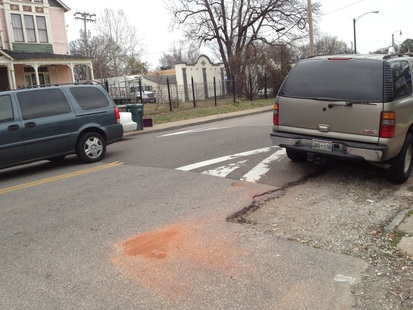HYPERLOCAL NEWS HUB BY THE UNIVERSITY OF MEMPHIS DEPARTMENT OF JOURNALISM
Residents Want Speed Humps to Slow Traffic in C-Y
Residents must work with the city in order to begin working toward the humps.
Huntley says, “They have been good at answering questions and helping with the process, but it is not a quick process and [we] have to follow up with the City on a regular basis, which is frustrating.”
Residents must first request an evaluation of a particular street from the city. The general requirements, even before the evaluation, are specific:
Once the initial request is approved, the city must determine if two traffic conditions are met, one involving speed and one involving volume of cars.
When asked how long this initial part takes, Ronda Curry, Traffic Engineer, City of Memphis, gave us a “two year estimate” that included time for the necessary studies and also “time to mark the street for the appropriate locations for speed humps and their corresponding signs.”
According to Edward Greene’s article in the Lamplighter, residents on Evelyn Avenue say they began the process years ago, but never received a petition to sign. “They were informed [by the city] that there was no longer funding available to continue with the project.”
Huntley says, “The speed hump process on Nelson has taken close to six years.”
When asked about the lack of money, Curry responded, “If there’s no money for that year, then none of the work can take place.”
“It costs approximately $3,200 per speed bump and each speed bump needs two signs at $229 per sign,” says Curry. “Three or four of the past ten years [the department] didn't get funding” which means “everything sits until the next year.”
If the city determines that the specified street does qualify for the speed humps, the community must have 75% of the street’s residents sign a petition for the work to be done.
Nelson Avenue’s residents have received the petition and are working on acquiring signatures. The speed humps will be placed between Tanglewood and Barksdale on Nelson.
The residents on Evelyn Avenue completed the petition and have returned it to the city; they are waiting for it to be approved and for the work to begin between Cooper and Barksdale.
The next step for Evelyn Avenue is the contract process, in which the city accepts bids and chooses a contractor for the work.
Curry says, “The contract process is what starts in January or February so that, hopefully, by the time the contract is approved and a contractor is lined up, it’s not too late in the year to do installations.”
Huntley says, “They have been good at answering questions and helping with the process, but it is not a quick process and [we] have to follow up with the City on a regular basis, which is frustrating.”
Residents must first request an evaluation of a particular street from the city. The general requirements, even before the evaluation, are specific:
- The street must be less than 40 feet wide
- It must have a speed limit of 30 MPH or less
- The request may require approval from the fire department
Once the initial request is approved, the city must determine if two traffic conditions are met, one involving speed and one involving volume of cars.
When asked how long this initial part takes, Ronda Curry, Traffic Engineer, City of Memphis, gave us a “two year estimate” that included time for the necessary studies and also “time to mark the street for the appropriate locations for speed humps and their corresponding signs.”
According to Edward Greene’s article in the Lamplighter, residents on Evelyn Avenue say they began the process years ago, but never received a petition to sign. “They were informed [by the city] that there was no longer funding available to continue with the project.”
Huntley says, “The speed hump process on Nelson has taken close to six years.”
When asked about the lack of money, Curry responded, “If there’s no money for that year, then none of the work can take place.”
“It costs approximately $3,200 per speed bump and each speed bump needs two signs at $229 per sign,” says Curry. “Three or four of the past ten years [the department] didn't get funding” which means “everything sits until the next year.”
If the city determines that the specified street does qualify for the speed humps, the community must have 75% of the street’s residents sign a petition for the work to be done.
Nelson Avenue’s residents have received the petition and are working on acquiring signatures. The speed humps will be placed between Tanglewood and Barksdale on Nelson.
The residents on Evelyn Avenue completed the petition and have returned it to the city; they are waiting for it to be approved and for the work to begin between Cooper and Barksdale.
The next step for Evelyn Avenue is the contract process, in which the city accepts bids and chooses a contractor for the work.
Curry says, “The contract process is what starts in January or February so that, hopefully, by the time the contract is approved and a contractor is lined up, it’s not too late in the year to do installations.”
Katie Hannings /MicroMemphis reporter

Katie Hannings covers Lifestyles for MicroMemphis.
You can send her story ideas here.
You can follow her on Twitter ( @K_Hannings)
